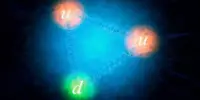The first team in the world to transmit more than 1 petabit per second (Pbit/s) with just a single laser and a single optical chip is an international group of researchers from Technical University of Denmark (DTU) and Chalmers University of Technology in Gothenburg, Sweden.
1 petabit corresponds to 1 million gigabits.
In the experiment, the researchers were able to send 1.8 Pbit/s, or twice the amount of data used on the entire Internet. solely by the light from one optical source is it conveyed. The light source is a specially created optical chip that can produce a rainbow spectrum of several hues, or various frequencies, using the light from a single infrared laser. As a result, a single laser’s single frequency (color) can be multiplied into hundreds of frequencies (colors) in a single chip.
It is termed a frequency comb because all the colors are fixed at a particular frequency distance from one another, much like the teeth on a comb. Then, it is possible to isolate each color (or frequency) and utilize it to imprint data. The frequencies can then be put back together and transmitted as data across an optical wire. Including a sizable amount of data, as the researchers have found.
One single laser can replace thousands
The experimental demonstration showed that a single chip could easily carry 1.8 Pbit/s, which with contemporary state-of-the-art commercial equipment would otherwise require more than 1,000 lasers.
Victor Torres Company, professor at Chalmers University of Technology, is head of the research group that has developed and manufactured the chip.
“What is special about this chip is that it produces a frequency comb with ideal characteristics for fiber-optical communications it has high optical power and covers a broad bandwidth within the spectral region that is interesting for advanced optical communications,” says Victor Torres Company.
All over the world, work is being done to integrate the laser source in the optical chip, and we’re working on that as well. The more components we can integrate in the chip, the more efficient the whole transmitter will be, i.e., laser, comb-creating chip, data modulators, and any amplifier elements. It will be an extremely efficient optical transmitter of data signals.
Leif Katsuo Oxenløwe
Interestingly enough, the chip was not optimized for this particular application.
“In fact, some of the characteristic parameters were achieved by coincidence and not by design,” says Victor Torres Company. “However, with efforts in my team, we are now capable to reverse engineer the process and achieve with high reproducibility microcombs for target applications in telecommunications.”
Enormous potential for scaling
A computational model was also developed by the researchers to investigate theoretically the fundamental potential for data transmission using a single chip that was the same as the semiconductor utilized in the experiment. The calculations showed enormous potential for scaling up the solution.
Professor Leif Katsuo Oxenløwe, Head of the Center of Excellence for Silicon Photonics for Optical Communications (SPOC) at DTU, says:
“Our calculations show that with the single chip made by Chalmers University of Technology, and a single laser we will be able to transmit up to 100 Pbit/s. The reason for this is that our solution is scalable both in terms of creating many frequencies and in terms of splitting the frequency comb into many spatial copies and then optically amplifying them, and using them as parallel sources with which we can transmit data. Although the comb copies must be amplified, we do not lose the qualities of the comb, which we utilize for spectrally efficient data transmission.”
This is how you pack light with data
Packing light with data is known as modulation. Here, the wave properties of light are utilized such as:
- Amplitude (the height/strength of the waves)
- Phase (the “rhythm” of the waves, where it is possible to make a shift so that a wave arrives either a little earlier or a little later than expected)
- Polarization (the directions in which the waves spread).
By changing these properties, you create signals. The signals can be translated into either ones or zeros and thus utilized as data signals.
Reduces Internet power consumption
The researchers’ solution bodes well for the future power consumption of the Internet.
“In other words, our solution provides a potential for replacing hundreds of thousands of the lasers located at Internet hubs and data centers, all of which guzzle power and generate heat. We have an opportunity to contribute to achieving an Internet that leaves a smaller climate footprint,” says Leif Katsuo Oxenløwe.
“Even though the researchers have broken the petabit barrier for a single laser source and a single chip in their demonstration, there is still some development work ahead before the solution can be implemented in our current communication systems,” according to Leif Katsuo Oxenløwe.
“All over the world, work is being done to integrate the laser source in the optical chip, and we’re working on that as well. The more components we can integrate in the chip, the more efficient the whole transmitter will be, i.e., laser, comb-creating chip, data modulators, and any amplifier elements. It will be an extremely efficient optical transmitter of data signals,” says Leif Katsuo Oxenløwe.
The research is published in Nature Photonics.
















